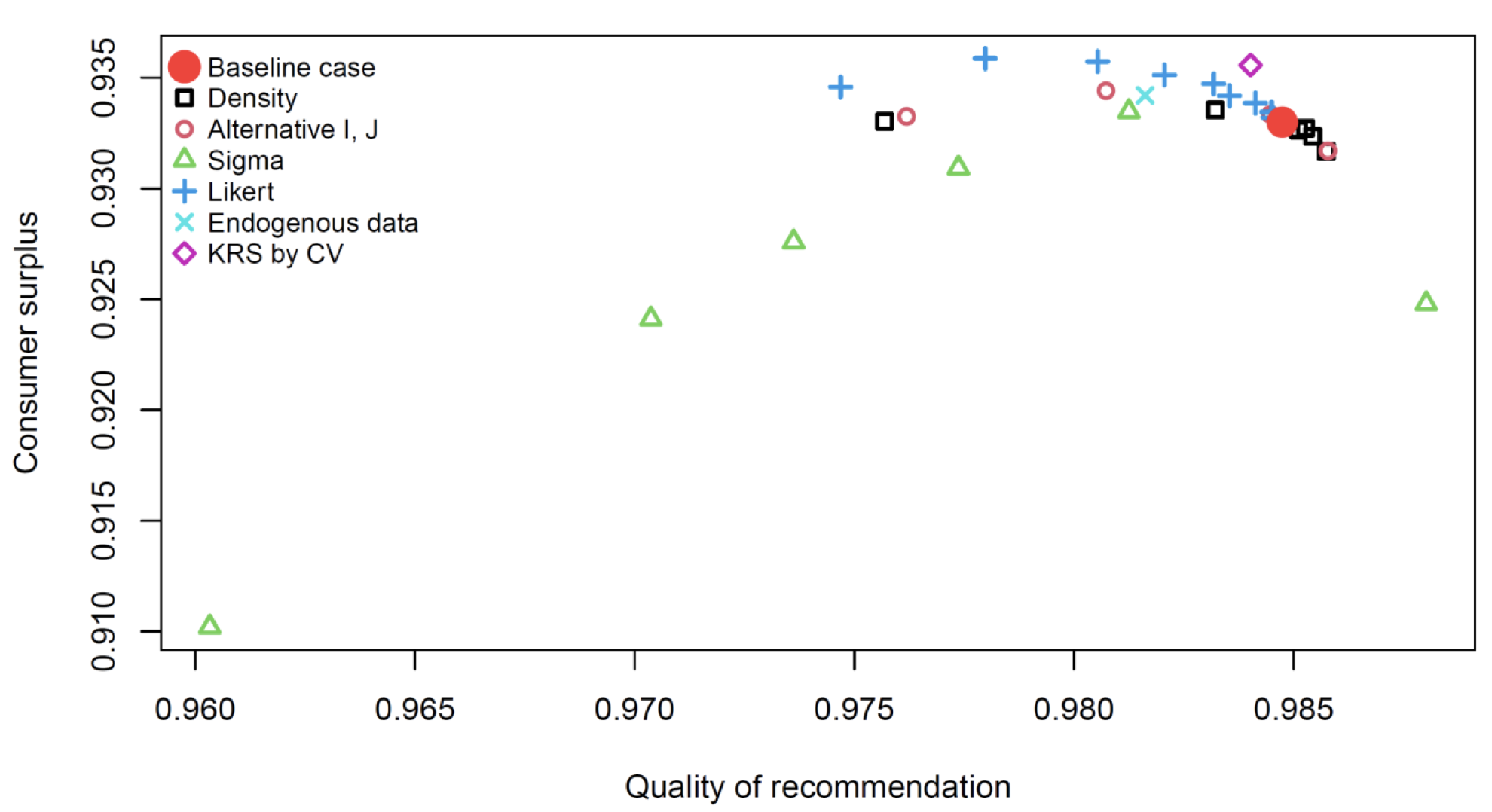In the digital age, consumers navigate a vast online landscape brimming with an endless array of products and a diverse range of content. Assisting them in this journey is a powerful and inconspicuous technological force known as recommender systems (RSs). These sophisticated algorithms work behind the scenes to understand our preferences and interests. They analyse explicit and implicit consumer feedback, such as ratings and previous engagement, and use this knowledge to filter the content that appears on our screens. By leveraging the ratings of similar items by similar users, RSs recommend products we are likely to purchase, present social media posts that resonate with us, deliver news stories aligned with our viewpoints, and display captivating content and images that genuinely capture our attention.
Because they have information on only a fraction of all user-item pairs, and because the feedback they observe are imperfect signals of true match values, the algorithms' predictions are imperfect. Nonetheless, they are transforming the process of consumer searches, in particular through the creation of personalised prominence. That is, consumers can initiate searches not randomly, but with products recommended to them. Consequently, consumer demand is altered. This transformation has the potential to impact firms' strategies and market outcomes.
In view of these developments, there have been growing concerns about the potential anticompetitive effects of algorithmic recommendations, with claims that RSs could increase market concentration, prompt firms to raise prices, and enable platforms to more effectively manipulate their recommendations, giving preferential treatment to certain products over others. These concerns, and related uncertainties discussed in a Vox column (Acemoğlu 2021), motivated the regulatory approach taken by the EU in 2022 with the Digital Service Act and the Digital Market Act.
In a recent paper (Calvano et al. 2023), we address these issues using a novel analytical framework. Our analysis confirms that all three concerns mentioned above are justified, but it also demonstrates that RSs have pro-competitive effects that are equally significant if not greater than the anti-competitive effects. RSs are not inherently anticompetitive.
However, our analysis also shows that increasing the amount and quality of information that algorithms can access may lead to reduced consumer welfare by increasing equilibrium prices. This means that there may be social benefits to limiting the platforms' access to personal information. In addition to protecting privacy, such limits could foster competition among the sellers, leading to higher consumer surplus.
Analytical framework
Our novel analytical framework combines advanced RSs with a search environment that features a large number of products, rational consumers searching for the best deal, and profit-maximising firms. Importantly, we allow for personalised recommendations but not for personalised prices. In other words, firms cannot price discriminate.
The RSs we use are of the latent factor type, like the winner of the 2009 Netflix prize.
As noted, their estimates are based on identifying similarities and differences among consumers and products. If consumer preferences were entirely idiosyncratic, as is often assumed in the search literature, these algorithms would not only be ineffective but also misleading, for any correlation found in the data would be spurious.
To address this issue, we construct a model of preferences and product differentiation that embeds correlations between consumers and products. The richness of this environment comes at the cost of complexity. We thus adopt numerical simulations, an approach that is increasingly employed to study the implications of complex AI systems in markets (see e.g. Asker et al. 2022, Calvano et al. 2020, Johnson et al. 2023).
This approach offers two distinct advantages. First, it enables a researcher to control the economic environment, allowing for the perfect identification of any sort of bias that the recommendation algorithm might display. Second, the approach is highly flexible and can accommodate different and perhaps more sophisticated algorithms, richer preference structures, and alternative user behavioural models. The flexibility of this approach makes it a valuable tool for competition authorities.
Our study compares two different scenarios. The first scenario, which we use as a benchmark, assumes that consumers rely only on individual searches. Consumers are aware of which products are available but must inspect a product, incurring a search cost, to learn its price and match value. In contrast, we consider a scenario whereby consumers receive personalised recommendations from an RS. While consumers are not obligated to follow these recommendations, they can start their search from the recommended products first.
Our comparison of these two scenarios primarily centres around firm pricing. However, the same framework can be applied to analyse various other decisions, such as entry and exit, product quality, R&D investment, or the acquisition of content by subscription-based platforms.
Matching, search, and prices
In the specific setting we analyse, RSs have three primary effects: they improve the matching between consumers and products, reduce costly searches, and change the demand for different products, leading firms to adjust their prices. The first two effects are positive, but with the third effect, RSs lead to price increases that have negative welfare effects. It is important to note that the price increase cannot be attributed to price discrimination, which is explicitly excluded by assumption.
Despite the negative price effect, our analysis shows that consumer surplus is often higher with RSs for reasonable parameter values. RSs reduce consumer surplus only when there are few products in the market, mostly horizontal product differentiation, and a very high search cost. Thus, we conclude that RSs cannot be generally regarded as anticompetitive.
Information and consumer welfare
However, a less optimistic picture emerges when we examine the impact of the amount and quality of information to which the algorithms have access. This may be affected by many different factors, but it turns out that the specific reason for the change in the level of information is not particularly important; it is the level of information that matters. We measure the level of information by the precision of the algorithm's estimates of actual consumer preferences.
Our analysis shows that as the level of information increases, so do prices, and the effect becomes increasingly strong. As a result, the relationship between the level of information and consumer welfare follows an inverted-U shape, as shown in Figure 1. Initially, consumer surplus increases with the level of information as the quality of the recommendations improves. However, beyond a certain point, the increase in prices surpasses the benefits of higher quality recommendations, and additional information ultimately decreases consumer surplus. Therefore, our findings suggest that implementing some degree of privacy protection may not only be beneficial for safeguarding personal information but may also have a positive effect on keeping prices in check.
Figure 1 The relationship between the level of information available to the recommender system (horizontal axis) and consumer surplus (vertical axis)
Note: Each distinct data point signifies varying environments, leading to different levels of information being provided to the algorithm. See Calvano et al. (2023) for details.
Manipulating recommendations
Our analysis also suggests that concerns over platforms' manipulation of recommendations may have been overstated, as such manipulation may actually intensify competition, leading to lower equilibrium prices. The prices of the favoured products decrease because their demand becomes more elastic. This in turn prompts suppliers of competing products to respond aggressively, resulting in greater competition and lower prices overall. This suggests that the most significant impact of manipulation is likely the reduction in profits seen by the competitors of the favoured products. Therefore, the manipulation of recommendations may be more of an exclusionary abuse aimed at excluding competitors from the market, rather than an exploitative one aimed at exploiting consumers directly.
References
Acemoğlu, D (2021), “Dangers of unregulated artificial intelligence,” VoxEU.org, 23 November.
Asker, J, C Fershtman and A Pakes (2022), “Artificial Intelligence, Algorithm Design and Pricing”, AEA Papers and Proceedings 112, 452–56.
Calvano, E, G Calzolari, V Denicolò and S Pastorello (2020), “Artificial intelligence, algorithmic pricing and collusion”, American Economic Review 110(10): 3267–3297.
Calvano E, G Calzolari, V Denicolò and S Pastorello (2023), “Artificial intelligence, algorithmic recommendations and competition”, working paper.
Johnson, J, A Rhodes and M Wildenbeest (2023), “Platform Design When Sellers Use Pricing Algorithms”, Econometrica, forthcoming.
Koren, Y, R Bell and C Volinsky (2019), “Matrix Factorization Techniques for Recommender Systems”, Computer 42(8): 30–37.








